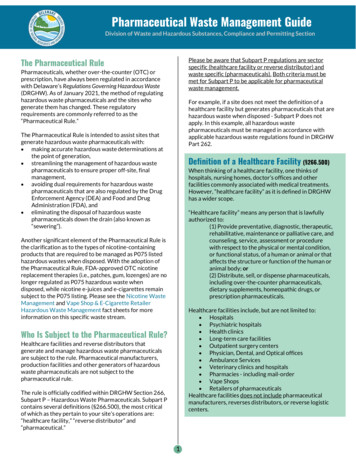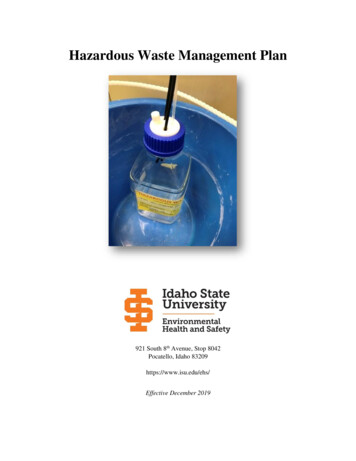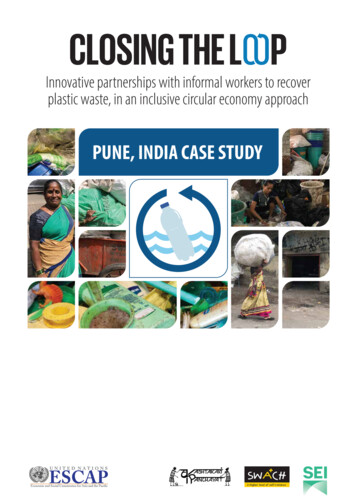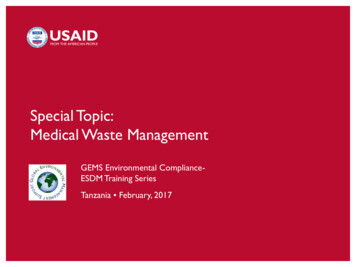
Transcription
Pharmaceutical Waste Management GuideDivision of Waste and Hazardous Substances, Compliance and Permitting SectionThe Pharmaceutical RulePlease be aware that Subpart P regulations are sectorspecific (healthcare facility or reverse distributor) andwaste specific (pharmaceuticals). Both criteria must bemet for Subpart P to be applicable for pharmaceuticalwaste management.Pharmaceuticals, whether over-the-counter (OTC) orprescription, have always been regulated in accordancewith Delaware’s Regulations Governing Hazardous Waste(DRGHW). As of January 2021, the method of regulatinghazardous waste pharmaceuticals and the sites whogenerate them has changed. These regulatoryrequirements are commonly referred to as the“Pharmaceutical Rule.”For example, if a site does not meet the definition of ahealthcare facility but generates pharmaceuticals that arehazardous waste when disposed - Subpart P does notapply. In this example, all hazardous wastepharmaceuticals must be managed in accordance withapplicable hazardous waste regulations found in DRGHWPart 262.The Pharmaceutical Rule is intended to assist sites thatgenerate hazardous waste pharmaceuticals with: making accurate hazardous waste determinations atthe point of generation, streamlining the management of hazardous wastepharmaceuticals to ensure proper off-site, finalmanagement, avoiding dual requirements for hazardous wastepharmaceuticals that are also regulated by the DrugEnforcement Agency (DEA) and Food and DrugAdministration (FDA), and eliminating the disposal of hazardous wastepharmaceuticals down the drain (also known as“sewering”).Definition of a Healthcare Facility (§266.500)When thinking of a healthcare facility, one thinks ofhospitals, nursing homes, doctor’s offices and otherfacilities commonly associated with medical treatments.However, “healthcare facility” as it is defined in DRGHWhas a wider scope.“Healthcare facility” means any person that is lawfullyauthorized to:(1) Provide preventative, diagnostic, therapeutic,rehabilitative, maintenance or palliative care, andcounseling, service, assessment or procedurewith respect to the physical or mental condition,or functional status, of a human or animal or thataffects the structure or function of the human oranimal body; or(2) Distribute, sell, or dispense pharmaceuticals,including over-the-counter pharmaceuticals,dietary supplements, homeopathic drugs, orprescription pharmaceuticals.Another significant element of the Pharmaceutical Rule isthe clarification as to the types of nicotine-containingproducts that are required to be managed as P075 listedhazardous wastes when disposed. With the adoption ofthe Pharmaceutical Rule, FDA-approved OTC nicotinereplacement therapies (i.e., patches, gum, lozenges) are nolonger regulated as P075 hazardous waste whendisposed, while nicotine e-juices and e-cigarettes remainsubject to the P075 listing. Please see the Nicotine WasteManagement and Vape Shop & E-Cigarette RetailerHazardous Waste Management fact sheets for moreinformation on this specific waste stream.Healthcare facilities include, but are not limited to: Hospitals Psychiatric hospitals Health clinics Long-term care facilities Outpatient surgery centers Physician, Dental, and Optical offices Ambulance Services Veterinary clinics and hospitals Pharmacies - including mail-order Vape Shops Retailers of pharmaceuticalsHealthcare facilities does not include pharmaceuticalmanufacturers, reverses distributors, or reverse logisticcenters.Who Is Subject to the Pharmaceutical Rule?Healthcare facilities and reverse distributors thatgenerate and manage hazardous waste pharmaceuticalsare subject to the rule. Pharmaceutical manufacturers,production facilities and other generators of hazardouswaste pharmaceuticals are not subject to thepharmaceutical rule.The rule is officially codified within DRGHW Section 266,Subpart P – Hazardous Waste Pharmaceuticals. Subpart Pcontains several definitions (§266.500), the most criticalof which as they pertain to your site’s operations are:“healthcare facility,” “reverse distributor” and“pharmaceutical.”1
Definition of a Reverse Distributor (§266.500)The aforementioned definition of “pharmaceutical”defines the item with respect to it being a product. Todetermine how (if at all) Subpart P is applicable to yourbusiness, a pharmaceutical must be evaluated when itbecomes a waste.Reverse distributors are the other business sectorrequired to manage pharmaceutical waste in accordancewith Subpart P. Reverse distribution is not the same asreverse logistics. Reverse distributors manageprescription pharmaceuticals, while reverse logisticoperators manage non-prescription pharmaceuticals andother retail items.When any pharmaceutical is disposed of or discarded, ahazardous waste determination is required. Making ahazardous waste determination on a wastepharmaceutical is the same as making a hazardous wastedetermination on any waste stream. The followingquestions can assist you in making a hazardous wastedetermination. Additional guidance is also found withinthe Basic Business Guide for Hazardous WasteManagement and Hazardous Waste Management: WasteDeterminations fact sheets.A “Reverse Distributor” is: Any person that receives and accumulatesprescription pharmaceuticals that are potentiallycreditable hazardous waste pharmaceuticals for thepurpose of facilitating or verifying manufacturercredit. Examples include forward distributors, third-partylogistic providers, and pharmaceutical manufacturers,that process prescription pharmaceuticals for thefacilitation of or verification of manufacturer credit.1. Is the waste excluded or exempt from being ahazardous waste?*Commonly excluded and/or exempted pharmaceuticalwastes are: household waste pharmaceuticals, and OTC pharmaceuticals, dietary supplements, orhomeopathic drugs that are legitimately used,reused or reclaimed.If your site meets the definition of a reverse distributor,please see the Reverse Distribution & Reverse Logisticsfact sheet for more guidance.Definition of a Pharmaceutical (§266.500)2. Is the waste a listed hazardous waste?*“Pharmaceutical” as defined in DRGHW includes, but isnot limited to: Dietary Supplements Prescription drugs OTC drugs Homeopathic drugs Compounded drugs Investigational drugs Pharmaceuticals remaining in non-emptycontainers Personal protection equipment (PPE)contaminated with pharmaceuticals Clean-up waste from spills of pharmaceuticals Electronic nicotine delivery systems (ENDS), suchas, e-cigarettes and vape pens Nicotine e-liquid/e-juice packaged for retail salefor use in ENDS, such as, pre-filled cartridges andvials.For pharmaceutical wastes, the P- and U- listed wastesare important to consider when making a hazardouswaste determination. While a site may generate otherlisted hazardous waste, the following is a list of P- andU- listed hazardous waste pharmaceuticals. Italicizedchemicals are chemotherapy agents.There are eight P-listed chemicals that are alsopharmaceuticals. These are:-Arsenic Trioxide (P012) -Epinephrine base (P042)-Nicotine (P075)-Nitroglycerin (P081)-Phentermine (P046)-Physostigmine (P204)-Physostigmine salicylate (P188)-Warfarin 0.3% (P001)There are 21 U-listed chemicals that are alsopharmaceuticals. These are:“Pharmaceutical” does not include dental amalgam,sharps, or infectious waste. Sharps and other infectiouswaste are considered solid wastes and must be managedin accordance with Delaware’s Regulations Governing SolidWaste (DRGSW) as applicable. For information oninfectious waste management and a full version ofDRGSW, visit: /infectious-Chloral hydrate (U034)-Chlorambucil (U035)-Cyclophosphamide (U058)-Daunomycin (U059)-Dichlorodifluoromethane (U075)-Diethylstilbestrol (U089)-Hexachlorophene (U132)-Lindane (U0129)-Melphalan (U151)-Mercury (U151)-Mitomycin C (U010)-Paraldehyde (U182)-Phenol (U188)-Reserpine (U200)-Resorcinol (U201)-Saccharin (U202)-Selenium sulfide (U205)-Streptozotocin (U206)-Trichloromonofluoromethane (U121)-Uracil mustard (U237)-Warfarin 0.3% (U248)Making a Hazardous Waste Determinationon Waste Pharmaceuticals3. Does the waste exhibit a hazardous characteristic?*2
Add the amount non-pharmaceutical hazardous wasteplus pharmaceutical hazardous waste to determine thetotal amount of hazardous waste generated by your site.You should keep these waste streams separate because ifSubpart P is applicable to your site, hazardous wastepharmaceuticals are required to be managed separatelythan all other hazardous waste generated at yourhealthcare facility. Once the total amount of all hazardouswaste has been determined, use the chart below toidentify your site’s generator category.Ignitable (D001) wastes have a flash point below140 F or is an ignitable compressed gas. Example: An aqueous drug formulationcontaining 24% or more of alcohol byvolume may exhibit this characteristicCorrosive (D002) wastes are liquids with a pH 2 or 12.5. Example: Compounded medication wastegenerated in a pharmacyReactive (D003) wastes chemically react withsubstances, such as water, producing toxic fumesand/or are capable of detonation. Example: NitroglycerinToxicity (D004 thru D043) These wastes will leach atoxic contaminant under acidic conditions, shouldthe leached contaminant exceed the regulatorylevel, the waste pharmaceutical is a hazardouswaste. Toxicity is determined by the ToxicityCharacteristic Leaching Procedure (TCLP). Example: A formulation containing lindaneused to treat lice or scabies could be D013when disposedA common waste stream for healthcare facilities toconsider when determining generator category is acutehazardous waste pharmaceutical residue remainingwithin containers. The pharmaceutical rule has newstandards for the management of containers which allowthose containers which held acute hazardous wastepharmaceuticals to be emptied through normal meansand not be regulated as hazardous waste should certainconditions be met. Thus, this new rule may greatly impacta site’s generator category. Below is one example of howthe new management standards influence generatorcategory, for further guidance and more examples pleaserefer to the Empty Container Residues section of thisguide. Example: Prior to the rule, pharmacies dispensingwarfarin (P001) were either counting only the weightof the pill residue within the container towards theirgenerator category or they were counting the weightof the warfarin container plus residue to determinegenerator category. Depending on how a pharmacywas counting, a pharmacy would be either a VSQG or aLQG because warfarin is a P-listed acute hazardouswaste. Under the new requirements, the containerwould be considered “empty” and the residues andcontainer would not be regulated as hazardous wasteand not counted towards generator category.*NOTE: Full details for exclusions, exemptions, listed andcharacteristic wastes, are found in DRGHW, Part 261.If a waste pharmaceutical is determined to be a hazardouswaste, Subpart P may be applicable to your healthcarefacility’s operations.To assist with the requirement to make hazardous wastedeterminations, a site may elect to manage allpharmaceutical waste as hazardous wastepharmaceuticals to avoid making hazardous wastedeterminations on each individual waste pharmaceutical.This provision is encouraged as it eliminates the necessityto evaluate potentially hundreds or thousands ofpharmaceuticals individually. If this option is selected, allwaste meeting the definition of a pharmaceutical must bemanaged as hazardous, there is no option to pick andchoose which waste pharmaceuticals will be managed asnon-hazardous or hazardous – all pharmaceuticals wouldbe managed as a hazardous waste pharmaceutical.Category:Monthly Generation Rate:VSQG 100 kg (220 lbs ) 1 kg (2.2 lbs) acute hazardous waste 100 kg – 1,000 kgSQGThe final step to determine if your healthcare facility isrequired to comply with Subpart P is to determinegenerator category.LQGDetermining Your Generator Category(220 lbs – 2,200 lbs) 1 kg (2.2 lbs) acute hazardous waste 1,000 kg (2,200 lbs) 1 kg (2.2 lbs) acute hazardous wasteApplicability of Subpart PGenerator category is based on the amount of hazardouswaste generated per calendar month. You will be either avery small quantity generator (VSQG), a small quantitygenerator (SQG), or a large quantity generator (LQG) ofhazardous waste. Do not include the amount of excludedand/or exempt waste, non-hazardous waste, used oil, oruniversal waste when determining your generatorcategory.Now that your healthcare facility’s generator categoryhas been determined: If your healthcare facility operatesas a SQG or LQG of hazardous waste – the site isrequired to manage hazardous waste pharmaceuticals inaccordance with Subpart P. If your healthcare facilityoperates as a VSQG, hazardous waste pharmaceuticalsmust be managed in accordance with Part 262 or Part266, Subpart P.3
non-pharmaceutical hazardous spent solvents in amonth, totaling 470 lbs of hazardous waste. Thehospital is a SQG and is required to managepharmaceuticals under Subpart P. Also, since the totalof non-pharmaceutical hazardous waste is 470 lbs,the site is still a SQG for non-pharmaceuticalhazardous waste and should select that status on thenotification form.Notification RequirementsSQG and LQG healthcare facilities are required to complywith Subpart P and must notify with the CAPS for eachsite that is operating under Subpart P. VSQGs that electto manage waste pharmaceuticals fully in accordance withSubpart P are also required to notify.Notification procedures are as follows: If this is your site’s first time notifying or your site hasan EPA identification number, but is not required tosubmit an Annual Report -- notification must becompleted by March 21, 2021 or within 60 days ofthese regulations becoming applicable to your site’soperations If your site has an EPA identification number andsubmits an Annual Report, notification of Subpart Pactivity can be made as part of the Annual Reportsubmission.The hazardous waste generator status on the notificationform is determined by the amount of only nonpharmaceutical hazardous waste generated within amonth. So, while your healthcare facility may be a SQG orLQG when counting all hazardous waste for theapplicability of Subpart P, it may not be a SQG or LQGafter counting just non-pharmaceutical hazardous waste.Therefore, a healthcare facility must recalculate itsgenerator category for only non-pharmaceuticalhazardous waste to determine its true generator status.The follow are examples of how to apply the notificationrequirement: Notification (and re-notification) are accomplished in oneof two ways, either by submitting the form electronicallythrough EPA’s RCRAInfo application site or mailing/emailing a completed Site Identification Form (EPA Form8700-12) to the CAPS. For more information on notifying,go the CAPS website at waste-reportingA pharmacy generated 3 lbs of acute hazardous wastepharmaceuticals and 85 lbs of non-pharmaceuticalhazardous waste in a month, totaling 88 lbs ofhazardous waste. Because of the amount of acutehazardous waste generated, the pharmacy is a LQGwith respect to determining applicability for SubpartP. However, because the amount non-pharmaceuticalhazardous waste is only 85 lbs, the pharmacy willnotify as operating under Subpart P (if electing tofully opt in) and indicate the site is a VSQG on thenotification form.Very Small Quantity Generator (VSQG)Healthcare FacilitiesIf your healthcare facility operates as a VSQG for bothhazardous waste pharmaceuticals and nonpharmaceutical hazardous waste, you must managehazardous waste pharmaceuticals in one of three ways:A hospital generated 70 lbs of non-acute hazardouswaste pharmaceuticals and 400 lbs of4
(3) Unexpired or less than one year past expirationdate.In accordance with §262.14 – which are the routine(non-pharmaceutical) hazardous waste managementrequirements.orOpt fully into using Subpart P and comply with allSubpart P regulations. If your healthcare facility optsinto Subpart P, you may not utilize the optionalprovisions within §266.504. As a reminder, you mustnotify with the CAPS.orIn accordance with §262.14 and utilize the optionalprovisions within §266.504. The optional provisionallows for:o Sending potentially creditable hazardous wastepharmaceuticals to a reverse distributor(§266.504(a)). See the Shipping Off-Site to aReverse Distributor section of this packet forguidance.o Sending hazardous waste pharmaceuticals offsite to another facility (§266.504(b)), providedthat: The receiving site is a healthcare facilityoperating under Subpart P and meeting theapplicable criteria of §266.502(l) and§266.503(b).or The VSQG is operating under§262.14(a)(6)(viii) and the receiving site is anon-healthcare facility operating as a LQGunder Part 262 and meets the conditions foroff-site consolidation as stated in §262.17(f).One of the conditions for this provision isthat both the VSQG and the LQG must becontrolled by the same person/entity.Non-prescription pharmaceuticals are not included in thisdefinition. OTC drugs, homeopathic drugs, and dietarysupplements are examples of non-prescriptionpharmaceuticals.A “non-creditable hazardous waste pharmaceutical” is a: prescription hazardous waste pharmaceutical thatdoes not have a reasonable expectation to be eligiblefor manufacturer credit, or A nonprescription hazardous waste pharmaceuticalthat does not have the reasonable expectation to belegitimately used, reused or reclaimed.Examples include, but are not limited to, investigationaldrugs, free pharmaceutical samples, contaminated PPE,floor sweepings, pharmaceutical spill clean-up materials,and residues of pharmaceuticals remaining in containers.When managing hazardous waste pharmaceuticals underSubpart P, requirements are not dependent on thehealthcare facility’s generator’s category. Instead,management requirements change based on whether thehazardous waste pharmaceutical is potentially creditableor non-creditable.Be aware that generator category remains a factor for allnon-pharmaceutical hazardous wastes as those wastesmust be managed in accordance with Part 262. Whenassessing the management requirements of Part 262, ahealthcare facility will utilized the requirements based ontheir recalculated generator category for only nonpharmaceutical hazardous waste since wastepharmaceuticals managed under Subpart P do not counttoward the site’s generator category once theapplicability of Subpart P has been determined.Types of Hazardous Waste PharmaceuticalsSubpart P breaks hazardous waste pharmaceuticals intothree types: “potentially creditable hazardous wastepharmaceutical”, “non-creditable hazardous wastepharmaceutical” and “evaluated hazardous wastepharmaceutical.” The first two types of hazardous wastepharmaceuticals are managed by healthcare facilities,while evaluated hazardous waste pharmaceuticals areonly managed by reverse distributors. The remainder ofthis fact sheet will address the management of potentiallycreditable and non-creditable hazardous wastepharmaceuticals. For information on the management ofevaluated hazardous waste pharmaceuticals, please seerefer to the Reverse Distribution & Reverse Logistics factsheet.Put another way, a healthcare facility managinghazardous waste pharmaceuticals under Subpart P doesnot have a generator category for hazardous wastepharmaceuticals, but it will be a VSQG, SQG, or LQG fornon-pharmaceutical hazardous waste.Managing Potentially Creditable HazardousWaste Pharmaceuticals (§266.503)Potentially creditable hazardous waste pharmaceuticalshave less burdensome management requirements underSubpart P than non-creditable hazardous wastepharmaceuticals. However, to be able to be managed assuch, the hazardous waste pharmaceuticals must meetthe four criteria previously listed.A “potentially creditable hazardous wastepharmaceutical” is a prescription hazardous wastepharmaceutical that has a reasonable expectation toreceive manufacturer credit and is:(1) In original manufacturer packaging (except forpharmaceuticals that were subject to a recall);(2) Undispensed; andAs a reminder, your healthcare facility may choose tomanage potentially creditable non-hazardous wastepharmaceuticals as potentially creditable hazardouswaste pharmaceuticals under Subpart P. This provision5
Reporting & Recordkeepingeliminates the need to make hazardous wastedeterminations on each, separate pharmaceutical thatmeets the creditable criteria.There is no annual reporting requirement for hazardouswaste pharmaceuticals managed under Subpart P.However, if your site still operates as a LQG due to othernon-pharmaceutical hazardous waste streams, an annualreport is required for those wastes.Accumulation Container RequirementsThere are no accumulation container requirements forpotentially creditable hazardous waste pharmaceuticalsas there are for other hazardous waste accumulationcontainers. For example, there is no labeling requirementand no requirement to keep the container closed.However, a good management practice is to treatpotentially creditable hazardous waste pharmaceuticalsas a commodity since they must continue to meet the fourcriteria to be allowed to be managed under this provision.A copy of the shipping paper utilized for each shipment tothe reverse distributor must be maintained for threeyears from the date of the shipment. The document mustconfirm the delivery was made to the reverse distributor.The shipping documents may be maintained physically orelectronically and must be readily available upon request.Documentation used to make hazardous wastedeterminations (e.g., test results, waste analysis, SDS) onpotentially creditable hazardous waste pharmaceuticals isnot required to be maintained.Accumulation LimitsThere is no limit to the amount of potentially creditablehazardous waste pharmaceuticals that may beaccumulated by a healthcare facility.Managing Non-Prescription Potentially CreditablePharmaceuticalsThere is no accumulation time limit by which potentiallycreditable hazardous waste pharmaceuticals need to beshipped off-site to a reverse distributor. However, sinceone of the criteria to meet the potentially creditablehazardous waste pharmaceutical is to be “unexpired orless than one year past expiration date”, it isrecommended that shipments be completed within a timeframe that avoids your healthcare facility from being outof compliance with this requirement.Your healthcare facility may generate wastepharmaceuticals that meet all the criteria of a potentiallycreditable hazardous waste pharmaceutical except thepharmaceutical isn’t a prescription (e.g., OTC medications,dietary supplements, electronic cigarette). As long asthere is a reasonable expectation of legitimate use, reuse(e.g., lawful donation or redistribution for its intendedpurpose) or reclamation of the non-prescriptionpharmaceutical waste, these are not considered a solidwaste. However, instead of utilizing a reverse distributor(since they may only accept prescriptionpharmaceuticals), your facility would utilize a reverselogistics center.Shipping Off-Site to Reverse DistributorHealthcare facilities must ship all potentially creditablehazardous waste pharmaceuticals to a reverse distributor.As previously mentioned, VSQGs may ship directly to areverse distributor or consolidate shipments at anotherhealthcare facility prior to shipping to a reversedistributor. Healthcare facilities are prohibited fromsending any non-pharmaceutical hazardous waste (e.g.,spent solvents, expired chemicals, etc.) or non-creditablepharmaceutical hazardous waste to the reversedistributor.Managing Non-Creditable Hazardous WastePharmaceuticals (§266.502)Managing non-creditable hazardous wastepharmaceuticals is similar to managing other hazardouswaste generated by your healthcare facility. For example,there are container standards, labeling requirements,accumulation time limits and manifesting requirements.When shipping potentially creditable hazardous wastepharmaceuticals off-site to a reverse distributor, ahazardous waste manifest is not required. There is also norequirement to utilize a permitted hazardous wastetransporter. Instead, healthcare facilities are allowed toutilize a shipping paper (e.g., bill of lading) and a commoncarrier (e.g., UPS, USPS, FedEx). Additionally, as always,the shipment must also be compliance with DOTrequirements.Additionally, your healthcare facility may choose tomanage non-creditable non-hazardous wastepharmaceuticals as non-creditable hazardous wastepharmaceuticals under Subpart P. This provisioneliminates the need to make hazardous wastedeterminations on each, separate waste pharmaceuticalthat is non-creditable. This makes compliance easier onhealthcare facilities since all of the generated noncreditable waste pharmaceuticals may be managed ashazardous waste.All shipments must be accounted for to ensure receipt bythe reverse distributor. If within 35 calendar days of theshipment your healthcare facility has not receivedconfirmation of delivery from the reverse distributor, youmust contact the carrier/transporter and reversedistributor to determine the status of the shipment.Accumulation Container RequirementsContainers used for the accumulation of non-creditablehazardous waste pharmaceuticals must be in good6
condition (e.g., not cracked or leaking) and compatiblewith the waste contained within. If a hazardous wastepharmaceutical is ignitable/reactive or incompatiblewastes are commingled within the same container,precautions must be taken to ensure the containerremains intact and there are no releases or fires.Placing the non-creditable hazardous wastepharmaceuticals into a designated area andidentifying the earliest date that any of the noncreditable hazardous waste became a waste.Shipping Off-Site for Final ManagementAll non-creditable hazardous waste pharmaceuticals mustbe shipped to a Treatment, Storage or Disposal facility(TSDF) for final management utilizing a permittedhazardous waste transporter. These wastes cannot beshipped to a reverse distributor.Should your healthcare facility generate a non-creditablehazardous waste pharmaceutical that is prohibited frombeing combusted (e.g., mercury arsenic trioxide), it mustbe accumulated within a separate container which islabeled with all applicable waste codes. If there is morethan one combustion prohibited hazardous wastepharmaceutical generated, they can be commingledwithin the same container provided there are noincompatibility issues. A list of hazardous wastepharmaceuticals that cannot be combusted is found inPart 266, Appendix XI.A hazardous waste manifest and a Land DisposalRestriction (LDR) form must be utilized for all noncreditable hazardous waste pharmaceutical shipmentsfrom your healthcare facility. When completing themanifest, specific hazardous waste codes are onlyrequired for the non-creditable hazardous wastepharmaceuticals that cannot be combusted. For all othernon-creditable hazardous waste pharmaceutical lineitems, you should write “PHARMS” or “PHRM” in thespace designated for waste codes. As a note, the U.S.Environmental Protection Agency (EPA) has stated theyprefer “PHRM” to be used on manifests since it a fourcharacter code that works best with the uniformmanifesting system.All containers must remain closed and controlled in amanner to prevent unauthorized access to the contents.All containers must be clearly labeled, “Hazardous WastePharmaceuticals.” Waste codes are not required for mostnon-creditable hazardous waste pharmaceuticals. Wastecodes are only required for non-creditable hazardouswaste pharmaceuticals that are prohibited from beingcombusted. The following is an example of anaccumulation container label:Should your healthcare facility have a shipment of noncreditable hazardous waste pharmaceuticals rejected bythe TSDF, please see §266.502(h) and/or §266.502(i)(2)(ii)for management requirements.Employee TrainingHealthcare facilities must train all employees that managenon-creditable hazardous waste pharmaceuticals. Thistraining is not an annual requirement, but a one-timerequirement. Employees must be trained to ensure theyare thoroughly familiar with proper waste handling andemergency procedures that are relevant to theirresponsibilities during normal operations andemergencies.For example, should a nurse need to dispose of an IV bagthat is not completely empty, the nurse would need to betrained in the proper management of non-creditablehazardous waste pharmaceuticals.Accumulation LimitsThere is no limit to the amount of non-creditablehazardous waste pharmaceuticals that may beaccumulated by a healthcare facility.You may find it easier and a best management practice totrain employees on the overall management ofpharmaceutical waste rather than only focusing on noncreditable hazardous waste pharmaceuticals, but this isnot required.Non-creditable hazardous waste pharmaceuticals may beaccumulated for up to one year without a permit orinterim status. You must be able to demonstrate thelength of time the waste has been accumulated. This canbe done by: Marking the accumulation container with theaccumulation start date, Maintaining an inventory system that identifies thedate when a non-creditable hazardous wastepharmaceutical first become a waste, orReporting & RecordkeepingThere is no annual reporting requirement for hazardouswaste pharmaceuticals managed under Subpart P.However, if your site still operates as a LQG due othernon-pharmaceutical hazardous waste streams, an annualreport is required for those wastes.7
A copy of the manifest utilized for each shipment must bemaintained for three years from the date of the shipment.Manifests may be maintained physically or electronicallyand must be readily available upon request. If a TSDF signed man
plus pharmaceutical hazardous waste to determine the total amount of hazardous waste generated by your site. You should keep these waste streams separate because if Subpart P is applicable to your site, hazardous waste pharmaceuticals are required to be managed separately than all other hazardous waste generated at your healthcare facility.










